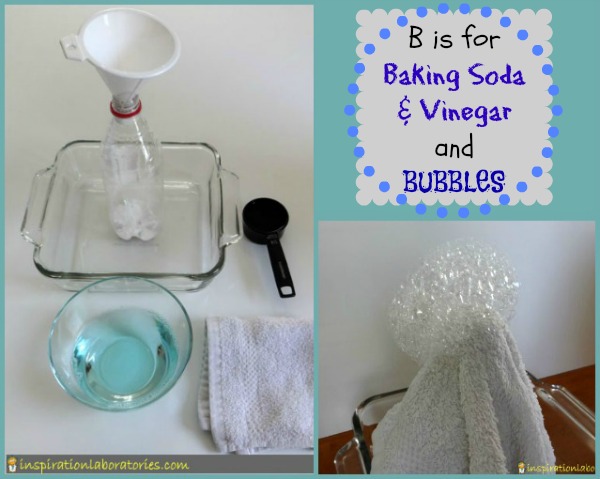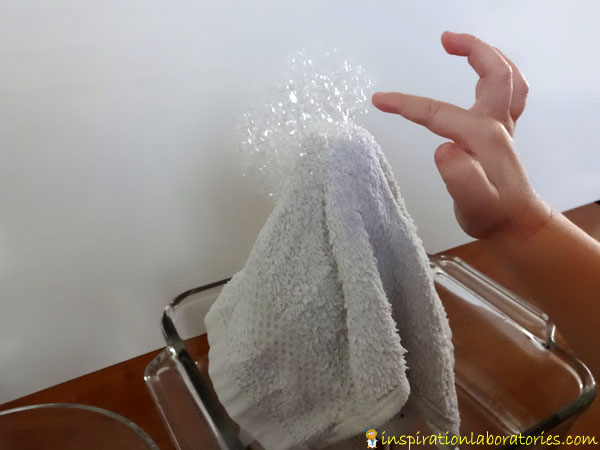B is for Baking Soda and Vinegar & Bubbles
This is the second post in the A to Z Science series. When I think about science activities for kids, baking soda and vinegar reactions always comes to mind. Exploring chemistry through materials we can find in our own kitchens is typically a safe way to learn about chemical reactions. In today’s activity, I have added a little twist to the standard mixing of baking soda and vinegar. B is for Baking Soda & Vinegar, and B is for Bubbles.

Materials

- plastic bottle (20 oz.)
- funnel
- 1 Tablespoon baking soda
- 2 teaspoons dishwashing liquid (like Dawn)
- 1 cup water
- washcloth
- 1/4 cup vinegar
Instructions
- Using the funnel, add 1 Tablespoon of baking soda to the plastic bottle.
- Add 2 teaspoons of dishwashing liquid to 1 cup of water. Stir.
- Dip the washcloth into the soapy water. Wring out excess water.
- Place the washcloth over the plastic bottle.
- Lift the washcloth, and add the vinegar to the plastic bottle.
- Quickly replace the washcloth and hold the top of the bottle.
- Bubbles will rise from the washcloth.
Video of Baking Soda and Vinegar Reaction
Watch the video below to see how it works.
Reminders and Cautions
Baking soda and vinegar are safe to touch. However, contact with the eyes should be avoided. Rinse eyes with water if your child happens to stick his hands in his eyes after touching vinegar. Wash hands when you are finished playing.
It goes without saying that this activity should be supervised by an adult.
The Science Behind It
Baking soda {sodium bicarbonate} is a base and vinegar {acetic acid} is an acid. When combined, they react to form water, a salt {sodium acetate}, and carbon dioxide gas. The bubbles produced by the reaction {in the bottle} are the carbon dioxide gas escaping the water. As the gas is formed, the air already in the plastic bottle is pushed up. As the air passes through the soapy washcloth, soap bubbles are formed.
Involving Your Child
Even toddlers and preschoolers can help with this experiment. Your child can help mix the soapy water. He can add the baking soda to the plastic bottle. You can even allow her to dip the washcloth in the soapy water and wring it out. You will most likely want to add the vinegar yourself. You need to quickly cover the top of the bottle with the washcloth. My son {almost 3 years old} didn’t dump the vinegar into the bottle quickly enough for me to cover it up with the washcloth {and he dumped most of the vinegar outside of the bottle}. We were a little more successful when using a funnel, but we got less bubbles. You can try using 1/2 cup of vinegar to combat this problem.

Questions to Ask Before
You can ask any of these questions before you run the experiment. Don’t worry about giving the right answers. It’s okay if your child does not know what will happen. The point is to think about what might happen. Then, we observe and see what does happen. Sometimes we’re right {especially if we have seen similar things before}, and sometimes we’re wrong.
What will happen when we mix baking soda and vinegar together? Answer: bubbles {or for a more sophisticated answer, see The Science Behind It section above.}
What did we add to the water? Answer: soap
We are going to place the soapy washcloth on top of the plastic bottle after adding baking soda and vinegar to the bottle. What do you think will happen with the soapy washcloth? Answer: soap bubbles will form {For a more sophisticated answer, see The Science Behind It section above.}
You can also ask about colors and smells. {It’s a good idea to smell things from a distance or use your hand to waft the scent towards you. Don’t put your nose directly over the liquid to smell it.}
If you have never introduced your child to the wonders of baking soda and vinegar reactions, that is completely fine. You may not want to ask any of the questions above. Just let your child enjoy the show.
Questions to Ask After
What happened? Answer: bubbles
What produced the bubbles? {You can ask about the bubbles inside the bottle as well as those on top of the washcloth.} Answer: the baking soda and vinegar produced the bubbles.
What will happen if you add more vinegar? Will more bubbles be produced? Let’s try it. Answer: You will see more bubbles in the bottle, but you most likely will not produce enough carbon dioxide to get more soap bubbles on the washcloth.
Try different amounts of baking soda and vinegar and see how many bubbles will be produced.
More Fun with Baking Soda and Vinegar
- Allow your child to simply mix vinegar and baking soda in a large container.
- Try one of these 20 baking soda science ideas.
- Paint with baking soda and vinegar.
What is your child’s favorite way to explore with baking soda and vinegar?
If you try this experiment, I would love to hear about it!
Don’t miss the rest of the A to Z Science series! Connect with Inspiration Laboratories on Twitter, Google+, or Facebook . You can also subscribe to my posts by e-mail.

Linking up here.


Leave a Reply